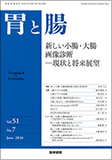Japanese
English
- 有料閲覧
- Abstract 文献概要
- 1ページ目 Look Inside
- 参考文献 Reference
要旨●消化管診断学の分野では,内視鏡機器の開発や発達に伴い,腺口形態(pit pattern)や微細血管の観察が可能になった.内視鏡像の解像度はさらに向上し,腫瘍・非腫瘍の鑑別診断や癌の深達度診断の精度が一層高くなり,診断学や治療技術は飛躍的に向上した.一方,超拡大内視鏡(EC)や共焦点内視鏡(CLE)は生検せずにreal timeで病理診断を行うという発想をもとに誕生した次世代の内視鏡である.ECやCLEは標的粘膜にスコープ先端を接触させることで,生きた細胞の生体内診断が顕微鏡レベルまで可能である.今後も検討を重ねることで,生物の本質に迫った診断を行うことが期待される.
With the recent advances in magnifying scopes, it has become possible to predict the histological type of a lesion or the depth of a cancer according to its surface microstructure(pit pattern). We have also reported that EC(endocytoscopy), an ultra-high magnification system, is useful to observe not only the structural atypia but also the cellular atypia in colorectal lesions. Although the first prototype was a probe type, an integrated type, the system embedded to a tip of an endoscope, was developed in 2005, which enables ordinary view, low power magnification up to ×80, and high power magnification of ×450 in vivo. An integrated EC also enables us to observe the bloodstream with NBI(narrow band imaging)mode. Endocytoscpic pathology, which is beyond the level of optical biopsy, represents diagnostics for living cells which is clearly different from the conventional histopathology for the specimens after formalin fixation.

Copyright © 2016, Igaku-Shoin Ltd. All rights reserved.


